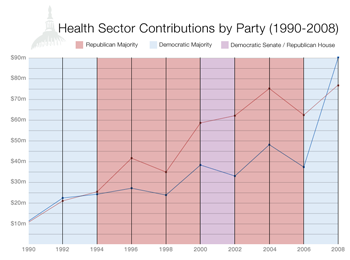Health Sector Contributions by Party (1990-2008)
From the 1990 election cycle to the 2008 election cycle the health sector contributed over $829 million to candidates for federal office and political parties. Over the course of those 19 years Congress debated comprehensive reform of the health sector, passed a Medicare drug benefit, made various changes to Medicare and Medicaid and established and expanded access to the Children’s Health Insurance Plan. A review of campaign contributions made available by the Center for Responsive Politics indicates that control of Congress, and the power exerted by that control, has been a key determinative factor in the party distribution of contributions by the health sector over the years.
 Beginning in the 1990 election cycle, Democrats received a slightly larger share of health sector contributions than Republicans, despite the Republican Party’s pro-business positions. This spread stays the same through the 1992 election, which included the election of the Democratic President Bill Clinton. Clinton’s push for comprehensive reform of the health sector in 1993-94 and the industry’s opposition to such reforms began to push their campaign contributions towards the Republicans. In 1994, Republicans surpassed Democrats in health sector contributions and retook both chambers of Congress.
Beginning in the 1990 election cycle, Democrats received a slightly larger share of health sector contributions than Republicans, despite the Republican Party’s pro-business positions. This spread stays the same through the 1992 election, which included the election of the Democratic President Bill Clinton. Clinton’s push for comprehensive reform of the health sector in 1993-94 and the industry’s opposition to such reforms began to push their campaign contributions towards the Republicans. In 1994, Republicans surpassed Democrats in health sector contributions and retook both chambers of Congress.
The health sector didn’t look back after 1994 giving overwhelmingly to the Republicans in Congress and their presidential nominees. While the previous three election cycles (1990, 1992, 1994) were all very close in the health sector contribution distribution between the parties, the 1996 election saw a full 60% of health sector contributions go to Republicans seeking office. This wide divide only increased over the years.
(Click the play button on the graphic below to see a visualization of the change in health sector contributions to the parties from 1990-2008. I’d advise selecting unique colors under the Color tab.)
The elections of 2002, 2004 and 2006 provided for the biggest health sector contribution disparities between the parties. In each of these elections Republicans pulled in over 60% of the health sector contributions to federal candidates and parties. The highest percentage came in the 2002 election cycle as Congress began to debate the inclusion of a prescription drug benefit within Medicare. In this election Republicans received 65% of health sector contributions. The resulting legislation, passed in 2003, wound up very friendly to the pharmaceutical industry. So friendly, in fact, that the chief author of the legislation, Rep. Billy Tauzin, left Congress and quickly signed on as the President and CEO of the industry’s Washington lobby shop, the Pharmaceutical Research and Manufacturers of America (PhRMA).
Over the next two election cycles the industry faced a Republican Party that was largely supportive of their interests–and had recently enacted legislation that they widely supported–and a Democratic Party that sought to enact sweeping reforms of the industry and seek further cost savings from the pharmaceutical industry in the new Medicare prescription drug plan. Facing this decision, the industry stayed with the party that controlled both the Congress and the Executive Branch–the Republicans. The industry gave 62% of their campaign contributions to Republicans in the 2006 election cycle despite the overwhelming evidence of imminent Democratic victory. Majority control and the nature of the Democrats’ campaign proposals kept the industry alongside the Republicans.
The 2006 election swung control of Congress to the Democrats for the first time in 12 years and with that came a major swing in campaign contributions from the health sector. Contributions shifted rapidly away from Republicans as Democrats stepped up to head the committees that would oversee and write legislation related to the health sector. The health sector had to also account for the unpopularity of the Republican Party and President George W. Bush. With almost every political prognosticator predicting another sweep for the Democrats, including the White House, the health sector had to prepare for the coming attempt to pass comprehensive health care reform, the holy grail of Democratic policy goals.
The health sector dramatically shifted their contributions from Republicans to Democrats in the 2008 election cycle. Democrats received 54% of all health sector contributions, the highest percentage they have received since the Center for Responsive Politics began tracking campaign contributions. Leading the way was presidential candidate Barack Obama. Obama, perhaps the largest recipient of health sector contributions in history, brought in over $19 million from the sector in the 2008 election cycle.
While the above graphics do not show 2010 health sector contributions the disparity between the parties has only grown. Democrats have received 58% of all health sector contributions. Republicans have fallen to their lowest percentage in recorded history. And the contributions did not come without benefits. The health sector was brought close into the discussion on comprehensive health care reform. The pharmaceutical industry, the hospital industry and doctors all signed onto legislation and helped to ultimately pass comprehensive reform. The final product included many concessions to these and other industries and cut out many long-standing Democratic policy priorities that the industries feared.

